The remains of servicemen of the Soviet Army and people from the Second World War period will be reburied from the Field of Mars on Mechnikova Street. This decision was taken by the executive committee of the Lviv City Council.
The Memorial Complex of Heroes of Ukraine will be set up at this place, in memory of the Ukrainian soldiers who gave their lives for the Independence of Ukraine.
“The field of Mars is a monument of history since 1972. Officially, it is believed that soldiers who died during the Second World War are buried here. However, most of them died in the period from 1944 to 1950 during punitive operations of the NKVD against Ukrainians in Galicia.
The architectural solution of the memorial is alternating strips of black and red granite, which should symbolize the “Georgian” ribbon. It is obvious that such symbols cannot exist now and be next to the burials of tortured victims of Zamarstiniv prison, UPA soldiers and the newest heroes.
We are preparing an architectural competition for the new Memorial project, which will cover the entire territory of the military cemetery,” says Lilia Onishchenko, head of the historical environment protection department.
Consultations with architects are currently ongoing regarding the terms of reference for the competition for the best project of the Heroes of Ukraine Memorial Complex.
“We are talking about changing the entire territory of the Field of Mars. This will be a new element of memorial architecture. In the developed preliminary concept of the Memorial, we envisage military burials of Heroes of Ukraine, a memorial park and a memorial square. It should be a place of silence and reflection,” noted the chief architect of Lviv, Anton Kolomeytsev.
The executive committee also determined the order and procedure for obtaining relevant permits from state authorities, and determining the very month of reburial for Soviet servicemen.
Historical reference
The territory of the current Lychakiv Military Cemetery (Marsovoy Pole), namely its upper western part, was occupied by the Austrian Military Cemetery after the First World War, which extended to modern Cheremshina Street. There is still a preserved brick gate of the Austrian military cemetery on this street. Soldiers of the Austrian army and Ukrainian Sich Riflemen were buried in a part of the Austrian military cemetery. After the exhumation, 44 individual and 23 group graves were made from 111 graves of the Ukrainian Sich Riflemen. These burials were moved to another section of the Austrian cemetery, which was previously located on the territory of the modern 82nd field of the Lychakiv cemetery (next to the still-preserved grave of Pavlo Liskevich, a member of the UGA).
In the western part of the former Austrian military cemetery there was also a private garden of the Bodnar family. In June 1941, the Bolsheviks took the garden. There they carried out mass executions of people. In 1946–1947, the Bolsheviks razed and dug up the Austrian military cemetery, and civilian and military burials were arranged in its place. Civil burials began here in 1946. Later, the Austrian military cemetery was joined to Lychakivskoye and formed the 82nd field, which was divided into separate plots.
Then, at the military cemetery for Red Army soldiers, 3,491 people were buried together with NKVD soldiers. According to the registration book, they include 1,252 Soviet soldiers who were buried between 1945 and 1950. According to archival data, military divisions of the NKVD, which fought in the Lviv region with units of the Ukrainian Insurgent Army, were buried in this cemetery, next to soldiers of the Soviet Army who died of wounds in Lviv hospitals. These persons were also involved in mass repressions against the local population.
In 1974, a cemetery of Red Army soldiers (Lychakiv Military Cemetery) was laid on the Field of Mars according to the project of architects Andriy Shulyar, Vasyl Kamenshchyk and sculptor Volodymyr Boyk. Under the black granite slabs, which are located on both sides of the main avenue, soldiers of the Red Army are reburied. Inscriptions with the names of the fallen on the slabs are mostly without dates of life, only the first few graves have dates of death. Perhaps because most of the years of death fell on 1945-1950 and did not coincide with the Second World War, the Communist Party decided not to write them on the granite slabs of the war memorial.
Candidate’s material of architecture Khrystyna Kharchuk

